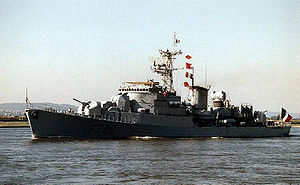|
Commandant Rivière-class frigate
The Commandant Rivière class was a class of frigates built for the French Navy in the late 1950s and early 1960s. Labeled "aviso-escorteur" (fr: "sloop-escort"), they were designed to perform the role of overseas patrol in peacetime and anti-submarine escort in wartime.[1] This vessel class is named after the French Navy officer Henri Rivière (1827–1883). Four similar ships were built for the Portuguese Navy as the João Belo class.[2] Design The main gun armament of the Commandant Rivière class consisted of three of the new French 100-millimetre (4 in) guns, with a single turret located forward and two turrets aft.[1][3] These water-cooled automatic dual-purpose guns could fire a 13.5-kilogram (30 lb) shell at an effective range of 12,000 metres (39,000 ft) against surface targets and 6,000 m (20,000 ft) against aircraft at a rate of 60 rounds per minute.[4] A quadruple 305 mm (12 in) anti-submarine mortar was fitted in 'B' position, aft of the forward gun and in front of the ship's superstructure,[1] capable of firing a 230 kg (510 lb) depth charge to 3,000 m (9,800 ft) or in the shore bombardment role, a 100 kg (220 lb) projectile to 6,000 m (20,000 ft).[5] Two triple torpedo tubes were fitted for anti-submarine torpedoes, while the ship's armament was completed by two 30 mm (1.2 in) Hotchkiss HS-30 cannon.[1] The ships had accommodation for an 80-man commando detachment with two fast landing boats, each capable of landing 25 personnel.[6] While the previous French frigates of the Le Corse and Le Normand classes were powered by steam turbines,[7] because a long-range was required for the overseas colonial role of the ships, the class was instead fitted with a 16,000-brake-horsepower (12,000 kW) two-shaft diesel powerplant, capable of propelling the ship at a speed of 26 knots (48 km/h; 30 mph), although 26.6 knots (49.3 km/h; 30.6 mph) was reached during trials.[8][9] Two ships of the class were fitted with modified power plants. Commandment Bory was powered by free-piston engines driving gas turbines, although it was refitted with a conventional diesel installation in 1974–1975, while Balny was fitted with an experimental CODAG (combined diesel and gas) installation, with a 11,500 hp (8,600 kW) and two 3,600 bhp (2,700 kW) diesel engines driving a single shaft. The CODAG arrangement took up less space, allowing 100 tons more fuel to be carried and giving a range of 13,000 nautical miles (24,000 km; 15,000 mi) at 10 knots (19 km/h; 12 mph). Balny omitted one 100 mm gun turret to accommodate the revised machinery.[6][10] Operational historyThe first ship to have been commissioned, but the second in her class, after Commandant Rivière, the prototype and lead ship of the series, was Victor Schœlcher, which entered service in October 1962, with all but one of the class following in the next 27 months. The exception was the CODAG powered Balny, which although launched in 1962 and completed in 1964, did not commission until 1970, being employed as a trials ship in the meantime.[1][10] Commandant Bourdais was used for fishery protection in the North Atlantic from 1963 to 1972,[11][12] while several of the ships of the class were used as training ships, including Victor Schœlcher (1961–1973)[13] and Commandant Bourdais.[5] In the 1970s, all except Balny had one 100 mm turret replaced by four MM 38 Exocet anti-ship missile launchers, while several of the ships had their 30 mm cannon replaced by Bofors 40 mm (1.6 in) guns.[6] In 1984–1985, Commandant Rivière was converted to a sonar-trials ship. The ship's armament was replaced by a single 40 mm Bofors gun and two 12.7 mm (0.50 in) machine guns, while the ship's stern was rebuilt to accommodate a hoist for a variable depth sonar, which was used to test various active and passive towed array sonars.[6][14] All French units were decommissioned in the early 1990s, save for three frigates that were sold to the Uruguayan Navy.[1][15] ShipsAll French ships were built by Arsenal de Lorient
See alsoNotes
References
Information related to Commandant Rivière-class frigate |
||||||||||||||||||||||||||||||||||||||||||||||||||||||||||||||||||||||||||||||||||||||||||||||||||||||||||||||||||||||||
